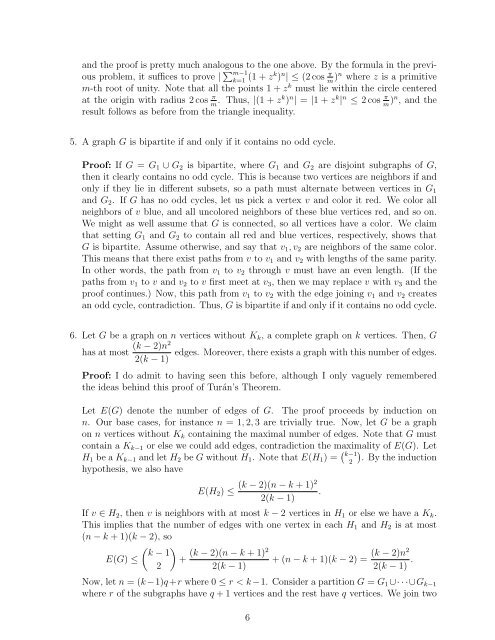Discrete Geometry and Extremal Graph Theory - IMSA
Discrete Geometry and Extremal Graph Theory - IMSA
Discrete Geometry and Extremal Graph Theory - IMSA
Create successful ePaper yourself
Turn your PDF publications into a flip-book with our unique Google optimized e-Paper software.
<strong>and</strong> the proof is pretty much analogous to the one above. By the formula in the previous<br />
problem, it suffices to prove | ∑ m−1<br />
k=1 (1 + zk ) n | ≤ (2 cos π m )n where z is a primitive<br />
m-th root of unity. Note that all the points 1 + z k must lie within the circle centered<br />
at the origin with radius 2 cos π . Thus, |(1 + m zk ) n | = |1 + z k | n ≤ 2 cos π m )n , <strong>and</strong> the<br />
result follows as before from the triangle inequality.<br />
5. A graph G is bipartite if <strong>and</strong> only if it contains no odd cycle.<br />
Proof: If G = G 1 ∪ G 2 is bipartite, where G 1 <strong>and</strong> G 2 are disjoint subgraphs of G,<br />
then it clearly contains no odd cycle. This is because two vertices are neighbors if <strong>and</strong><br />
only if they lie in different subsets, so a path must alternate between vertices in G 1<br />
<strong>and</strong> G 2 . If G has no odd cycles, let us pick a vertex v <strong>and</strong> color it red. We color all<br />
neighbors of v blue, <strong>and</strong> all uncolored neighbors of these blue vertices red, <strong>and</strong> so on.<br />
We might as well assume that G is connected, so all vertices have a color. We claim<br />
that setting G 1 <strong>and</strong> G 2 to contain all red <strong>and</strong> blue vertices, respectively, shows that<br />
G is bipartite. Assume otherwise, <strong>and</strong> say that v 1 , v 2 are neighbors of the same color.<br />
This means that there exist paths from v to v 1 <strong>and</strong> v 2 with lengths of the same parity.<br />
In other words, the path from v 1 to v 2 through v must have an even length. (If the<br />
paths from v 1 to v <strong>and</strong> v 2 to v first meet at v 3 , then we may replace v with v 3 <strong>and</strong> the<br />
proof continues.) Now, this path from v 1 to v 2 with the edge joining v 1 <strong>and</strong> v 2 creates<br />
an odd cycle, contradiction. Thus, G is bipartite if <strong>and</strong> only if it contains no odd cycle.<br />
6. Let G be a graph on n vertices without K k , a complete graph on k vertices. Then, G<br />
(k − 2)n2<br />
has at most edges. Moreover, there exists a graph with this number of edges.<br />
2(k − 1)<br />
Proof: I do admit to having seen this before, although I only vaguely remembered<br />
the ideas behind this proof of Turán’s Theorem.<br />
Let E(G) denote the number of edges of G. The proof proceeds by induction on<br />
n. Our base cases, for instance n = 1, 2, 3 are trivially true. Now, let G be a graph<br />
on n vertices without K k containing the maximal number of edges. Note that G must<br />
contain a K k−1 or else we could add edges, contradiction the maximality of E(G). Let<br />
H 1 be a K k−1 <strong>and</strong> let H 2 be G without H 1 . Note that E(H 1 ) = ( )<br />
k−1<br />
2 . By the induction<br />
hypothesis, we also have<br />
E(H 2 ) ≤<br />
(k − 2)(n − k + 1)2<br />
.<br />
2(k − 1)<br />
If v ∈ H 2 , then v is neighbors with at most k − 2 vertices in H 1 or else we have a K k .<br />
This implies that the number of edges with one vertex in each H 1 <strong>and</strong> H 2 is at most<br />
(n − k + 1)(k − 2), so<br />
( ) k − 1<br />
E(G) ≤ +<br />
2<br />
(k − 2)(n − k + 1)2<br />
2(k − 1)<br />
+ (n − k + 1)(k − 2) =<br />
(k − 2)n2<br />
2(k − 1) .<br />
Now, let n = (k −1)q +r where 0 ≤ r < k −1. Consider a partition G = G 1 ∪· · ·∪G k−1<br />
where r of the subgraphs have q + 1 vertices <strong>and</strong> the rest have q vertices. We join two<br />
6
















